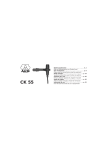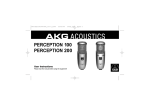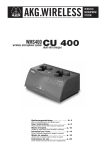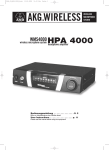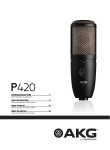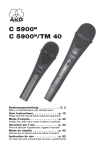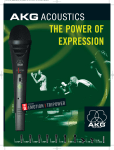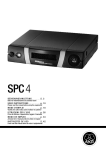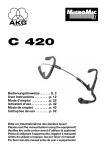Download AKG Perception 100 Microphone
Transcript
PerceptionManual_intl_final 07/11/05 11:27 Uhr PERCEPTION 100 PERCEPTION 200 User Instructions Please read the manual before using the equipment! Seite 1 PerceptionManual_intl_final 07/11/05 1 Precaution/Unpacking 1.1 Precaution Please make sure that the piece of equipment your microphone will be connected to fulfills the safety regulations in force in your country and is fitted with a ground lead. 1.2 Unpacking Check that the packaging contains all of the items listed for your microphone. Should any item be missing, please contact your AKG dealer. PERCEPTION 100: • Microphone • Stand adapter • Mini poster PERCEPTION 200: • • • • 2 Microphone Spider suspension Carrying case Mini poster 11:27 Uhr Seite 2 2 Description 2.1 Introduction Thank you for purchasing an AKG product. This Manual contains important instructions for setting up and operating your equipment. Please take a few minutes to read the instructions below carefully before operating the equipment and keep the Manual for future reference. Have fun and impress your audience! The PERCEPTION 100 and PERCEPTION 200 are heavy-duty, rugged true condenser microphones built to the same strict quality standards as all other AKG products. Designed on the basis of AKG’s decades of know-how and feedback from sound engineers around the world using AKG studio microphones every day, these general-purpose 1-inch large-diaphragm microphones bring AKG studio quality to the worlds of recording, live sound, and broadcasting. 2.2 Common Features The PERCEPTION 100 and 200 share the following features: • Cardioid polar pattern: The microphone is most sensitive to sounds arriving from in front of it while picking up much less of sounds arriving from the sides or rear (from monitor speakers or neighboring instruments). This makes the microphone equally suited for recording and onstage use. • Gold-sputtered diaphragm: The diaphragm is made of a plastic foil that is gold-sputtered on one side only to prevent shorting to the back electrode even at extremely high sound pressure levels. PerceptionManual_intl_final 07/11/05 • All-metal body: The all-metal body adds to the rejection of RF interference so you can use the microphone near transmitter stations and along with wireless microphones or other communications equipment. The extremely rugged, heavy body and sturdy front grill protect the microphone from damage from tough handling on stage. • High headroom, minimum distortion: Capable of handling sound pressure levels up to 135 dB without introducing perceptible distortion and built to resist high temperatures and humidity, the microphone will give excellent results in a wide range of applications. 2.3 PERCEPTION 200 Added Features The PERCEPTION 200 is basically identical to the PERCEPTION 100 but provides 11:27 Uhr Seite 3 the following additional features: • Bass cut filter: Selector 1 on the microphone front (refer to fig. 1) further reduces low-end distortion caused by footfall or wind noise, etc. The filter also minimizes the proximity effect that close-in miking from less than 4 inches causes in any unidirectional microphone.The filter rolls off at 12 dB/octave from 300 Hz downward. • Switchable preattenuation pad: Selector 2 on the microphone front (refer to fig. 1) lets you increase the headroom by 10 dB for distortionfree close-in recording. The preattenuation pad prevents the microphone's output level, particularly at low frequencies, from overloading the miniature transformers used in many mixer input stages, etc. 1 2 Fig. 1: Bass cut and preattenuation switches on PERCEPTION 200 front. 3 PerceptionManual_intl_final 07/11/05 2.4 Optional Accessories • MK 9/10 10-m (30-ft.) 2-conductor shielded cable with male and female XLR connectors • N 62, N 66 AC phantom power supplies • B 18 + A 48V battery supply and DC/DC converter for 48-V phantom powering • PF 100 studio pop screen • ST 102A, ST 200, ST 305 floor stands • W 4000 external windcscreen 11:27 Uhr Seite 4 3 Interfacing 3.1 General Section 3 applies to both the PERCEPTION 100 and the PERCEPTION 200. The microphone uses a true condenser transducer designed for 48-volt phantom powering to DIN 45 596/IEC 268-15. Neither the diaphragm nor the backplate are permanently polarized, so the microphone needs an external power supply. The microphone provides a balanced output on a 3-pin male XLR connector: Pin 1: ground Pin 2: hot Pin 3: return 2 2.3 Mic Phantom 1 Mic 2.2 Fig. 2: Connecting to a balanced input with (2.2) or without (2.3) phantom power. 4 PerceptionManual_intl_final 07/11/05 11:27 Uhr Seite 5 You can connect the microphone either to a balanced microphone input with or without phantom power or an unbalanced microphone input. Important: Using any power supply other than those recommended by AKG may damage your microphone and will void the warranty. 3.2 Input with Phantom Power Refer to fig. 2. 1. Use an XLR cable (e.g., the optional MK 9/10 from AKG) to connect the microphone (1) to a balanced XLR input with phantom power. 2. Switch the phantom power on. (Refer to the user manual of the unit to which you connected your microphone.) 3.4 Unbalanced Input Refer to fig. 3. Use a cable with a female XLR connec- 3.3 Input with No Phantom Power Refer to fig. 2. 1. If your mixer provides no phantom power, connect an optional AKG phantom power supply (N 62, N 66, B 18 + A 48V) between the microphone and the mixer. 1 2 Mic Phantom tor and TS jack plug: 1. On the XLR connector, use a wire bridge to connect pin 1 to pin 3 and the cable shield. 2. Connect the inside wire of the cable to pin 2 on the XLR connector and the tip contact of the jack plug. Fig. 3: Connecting to an unbalanced input. 5 PerceptionManual_intl_final 07/11/05 Note: Unbalanced cables may pick up interference from stray magnetic fields near power or lighting cables, electric motors, etc. like an antenna. This may introduce hum or similar noise when you use a cable that is longer than 16 feet (5 m). 11:27 Uhr Seite 6 4 Using Your Microphone 4.1 General Hints The PERCEPTION 100 and PERCEPTION 200 are general-purpose cardioid microphones for recording, broadcast, and onstage use. Every instrument radiates its sound in a specific way. Therefore, to get the best sound it is crucial to experiment with microphone placement. The following hints apply to both the PERCEPTION 100 and PERCEPTION 200. • The front of the microphone is the side of the body with the AKG logo on it. Therefore, always aim the logo at the sound source you are going to record! Being a unidirectional (cardioid) microphone, the PERCEPTION will pick up very little sound from the rear. 6 PERCEPTION 100 PERCEPTION 200 Fig. 4: Microphone front. PerceptionManual_intl_final 07/11/05 • When recording wind instruments or vocals, make sure not to blow or sing directly into the microphone. To avoid unwanted wind and pop noise or moisture problems, place an optional PF 100 pop screen from AKG between the microphone and vocalist/instrument. • Keep the microphone dry. Moisture from blowing or singing directly at the capsule from a short distance, or extremely high humidity may cause the microphone to start crackling or go very quiet due to partial short circuits in the polarization voltage. • If you use the microphone in the open air, use an optional AKG W 4000 windscreen to protect the microphone from moisture and reduce wind noise. 11:27 Uhr Seite 7 4.2 PERCEPTION 200 • High volume instruments: You can use this microphone for close-in recording of very loud instruments (brass instruments, kick drum, etc.). Just switch the preattenuation pad in to increase the microphone’s capability of handling sound pressure levels to 145 dB. • Low-frequency noise: To suppress low-frequency noise such as air conditioning rumble, footfall noise, or traffic sounds, switch the bass cut filter in. 5 Cleaning To clean the surface of the microphone body, use a soft cloth moistened with water. 7 PerceptionManual_intl_final 07/11/05 11:27 Uhr Seite 8 6 Troubleshooting Problem No sound. Possible Cause Remedy 1. Power to mixer and/or amplifier is off. 2. Channel or master fader on mixer, or volume control on amplifier is at zero. 1. Switch power to mixer or amplifier on. 2. Set channel or master fader on mixer or volume control on amplifier to desired level. 3. Connect microphone to mixer or amplifier. 4. Check cable connectors for secure seat. 5. Check cable and replace if damaged. 6. Switch phantom power on. Phantom power supply: connect to power outlet or insert battery (batteries). Check cable and replace if necessary. 3. Microphone is not connected to mixer or amplifier. 4. Cable connectors are seated loosely. 5. Cable is defective. 6. No supply voltage. Distortion. 8 1. Channel gain control on mixer set too high. 1. Turn gain control down CCW. PerceptionManual_intl_final 07/11/05 11:27 Uhr Seite 9 6 Troubleshooting Problem (Distortion) Crackling noises or low output. Possible Cause Remedy 2. Microphone too close to sound source. 2. Move microphone further away from sound source. (PERCEPTION 200 only:) Switch preattenuation pad in. • Partial short circuits due to excessive humidity. • Place microphone in warm, dry room and allow to dry. 9 PerceptionManual_intl_final 07/11/05 11:27 Uhr Seite 10 7 Specifications 7.1 PERCEPTION 100 and PERCEPTION 200 Type: 1-inch large-diaphragm, true condenser pressure-gradient microphone Polar pattern: cardioid Open-circuit sensitivity: 18 mV/Pa (-35 dBV) Frequency range: 20 Hz to 20 kHz (see frequency response trace) Impedance: ≥ 200 ohms Recommended load impedance: ≥ 1000 ohms Equivalent noise level to CCIR 468-2: 26 dB Equivalent noise level to IEC 60268-4 (A-weighted): 16 dB-A Signal/noise ratio re 1 Pa (A-weighted): 78 dB Max. SPL for 0.5% THD: 135 / 145 dB SPL (0 / -10 dB) Environment: temperature: -10°C to +60°C R.H.: 80% (+25°C) 10 Powering: Current consumption: Connector: Dimensions: Net weight: 48 V ±5 V phantom power to DIN 45 596 / 268-15IEC ≤2 mA 3-pin XLR (pin 2 hot) 53 dia. x 160 mm high / 2 x 6.3 in. 525 g / 1.2 lbs. 7.2 PERCEPTION 200 only Bass cut filter slope: 12 dB/octave, 300 Hz Preattenuation pad: -10 dB (switchable) FCC Statement The device complies with part 15 of the FCC rules. Operation is subject to the following two conditions: (1) this device may not cause harmful interference, and (2) this device must accept any interference received, including interference that may cause undesired operation. PerceptionManual_intl_final 07/11/05 11:27 Uhr Seite 11 7 Specifications PERCEPTION 100 Frequency Response PERCEPTION 100 Polar Diagram PERCEPTION 200 Frequency Response PERCEPTION 200 Polar Diagram 11 PerceptionManual_intl_final 07/11/05 11:27 Uhr Seite 12 The International Page English This product conforms to the standards listed in the Declaration of Conformity. To order a free copy of the Declaration of Conformity, visit http://www.akg.com or contact [email protected] Deutsch Dieses Produkt entspricht den in der Konformitätserklärung angegebenen Normen. Sie können die Konformitätserklärung auf http://www.akg.com oder per E-Mail an [email protected] anfordern. 12 Français Ce produit est conforme aux normes citées dans la Déclaration de Conformité, dont vous pouvez prendre connaissance en consultant le site http://www.akg.com ou en adressant un e-mail à [email protected]. Español Este aparato corresponde a las normas citadas en la declaración de conformidad. Esta última está disponible en el sitio http://www.akg.com o puede ser s o l i c i t a d a a l c o r re o e l e c t r ó n i c o [email protected]. Italiano Questo prodotto corrisponde alle norme elencate nella dichiarazione di conformità, che è disponibile al sito http://www.akg.com oppure all'indirizzo email [email protected]. Português Este produto corresponde às normas citadas na declaração de conformidade, que pode pedir na nossa página da web http://www.akg.com, ou enviando-nos um email para [email protected]. PerceptionManual_intl_final 07/11/05 11:27 Uhr Seite 13 Notizen • Notes • Notes • Note • Notas • Notas 13 PerceptionManual_intl_final 07/11/05 11:27 Uhr Seite 14 Notizen • Notes • Notes • Note • Notas • Notas 14 PerceptionManual_intl_final 07/11/05 11:27 Uhr Seite 15 Notizen • Notes • Notes • Note • Notas • Notas 15 Mikrofone · Kopfhörer · Drahtlosmikrofone · Drahtloskopfhörer · Kopfsprechgarnituren · Akustische Komponenten Microphones · Headphones · Wireless Microphones · Wireless Headphones · Headsets · Electroacoustical Components Microphones · Casques HiFi · Microphones sans fil · Casques sans fil · Micros-casques · Composants acoustiques Microfoni · Cuffie HiFi · Microfoni senza filo · Cuffie senza filo · Cuffie-microfono · Componenti acustici Micrófonos · Auriculares · Micrófonos inalámbricos · Auriculares inalámbricos · Auriculares con micrófono · Componentes acústicos Microfones · Fones de ouvido · Microfones s/fios · Fones de ouvido s/fios · Microfones de cabeça · Componentes acústicos Technische Änderungen vorbehalten. Specifications subject to change without notice. Ces caractéristiques sont susceptibles de modifications. Ci riserviamo il diritto di effettuare modifiche tecniche. Nos reservamos el derecho de introducir modificaciones técnicas. Especificações sujeitas à mudanças sem aviso prévio. AKG Acoustics GmbH Lemböckgasse 21–25, P.O.B. 158, A-1230 Vienna/AUSTRIA, Tel: (+43 1) 86 654-0*, Fax: (+43 1) 86 654-7516, www.akg.com, e-mail: [email protected], Hotline: (+43 676) 83200 888, [email protected] AKG Acoustics GmbH Bodenseestraße 228, D-81243 München/GERMANY, Tel: (+49 89) 87 16-0, Fax: (+49 89) 87 16-200, www.akg.com/de, e-mail: [email protected], Hotline: (+49 89) 87 16-22 50, [email protected] AKG ACOUSTICS, U.S. 914 Airpark Center Drive, Nashville, TN 37217, U.S.A., Tel: (+1 615) 620-3800, Fax: (+1 615) 620-3875, www.akgusa.com, e-mail: [email protected] For other products and distributors worldwide see our website: www.akg.com 09/05/9100 U 1166

















